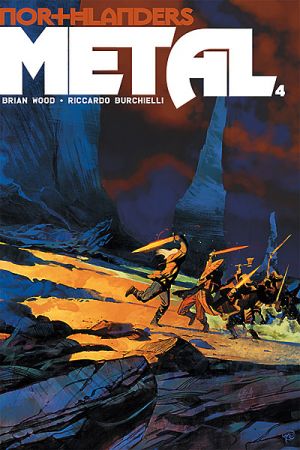|
|
 |
One of the strengths of Northlanders has been its rigid adherence to its biting realism. Another has been its awareness of the cyclical nature of human history. There’s no thunder gods or conniving tricksters running around tossing lighting bolts at one another. As “Metal” progresses though, it looks more and more like goddesses and draugrs are being treated as real…or so it seems. It’s entirely possible that all of the events of the tale are taking place in the mind of Erik as he remains chained, as shown in the first installment of “Metal,” awaiting sentencing for his first insurgent actions. Maybe the entire episode will be revealed to be a fever dream. Maybe it is all still in Erik and Ingrid’s imagination, and they are seeing Hulda and Black Karl, the draugr, as figments of such. It seems that every day people are seeing images of Christ in either cherry tree limbs or loafs of bread, so perhaps the story, which is being told from Erik’s perspective, is simply portraying what Erik believes he is seeing. Either way it’s still an interesting, intelligent, and relevant tale that, again like all of the masterful tales Wood has crafted thus far in Northlanders, holds a mirror up to our own society and its social, religious, economic, and political conflicts (and delusions). Maybe Wood has envisioned this tale as a tribute to, or as inspired by, Norwegian metal (as in music) that often focuses on such themes as contained herein. I’m not sure if Wood is a metal music fan, so that’s just pure speculation on my part, but it is a pretty cool idea nonetheless…and the cover to the first issue of the story arc did look like the cover of a metal band’s CD…
Riccardo Burchielli continues to bring to life Erika and Ingrid’s adventures. As stated in my look at issue #30 of Northlanders, Burchielli continues to be one of a lengthening line of superb artists who have worked on Northlanders which includes Leandro Fernandez and Davide Gianfelice, all of which are similar in style, but have their own unique way of recreating facial expressions. Burchielli’s somewhat unreal and strangely distorted visages in “Metal” may be a clue as to the nature of the reality or unreality of this tale.
Overall, I still really look forward to Northlanders each month. The week it is published it sits on the top of my reading pile, and is one of the rare monthly books I read that often gets the privilege of being read twice. Several great Vertigo series have unfortunately folded, but thankfully (and justly) Northlanders soldiers on, to the benefit of all comic readers who appreciate a book that is a cut above the field.
© Copyright 2002-2020 by Toon Doctor Inc. - All rights Reserved. All other texts, images, characters and trademarks are copyright their respective owners. Use of material in this document (including reproduction, modification, distribution, electronic transmission or republication) without prior written permission is strictly prohibited.

